The Confederate flag has a complex history in the United States. Alongside the nation’s growing acknowledgment of systemic racism in recent years, the flag predictably makes appearances at white supremacist gatherings.
But how did the battle flag, also known as the “Southern Cross,” come to represent the Confederacy in the first place? It’s a story of rebellion, racism, and disagreement over the true history of the American Civil War. Here’s the history of the flag.
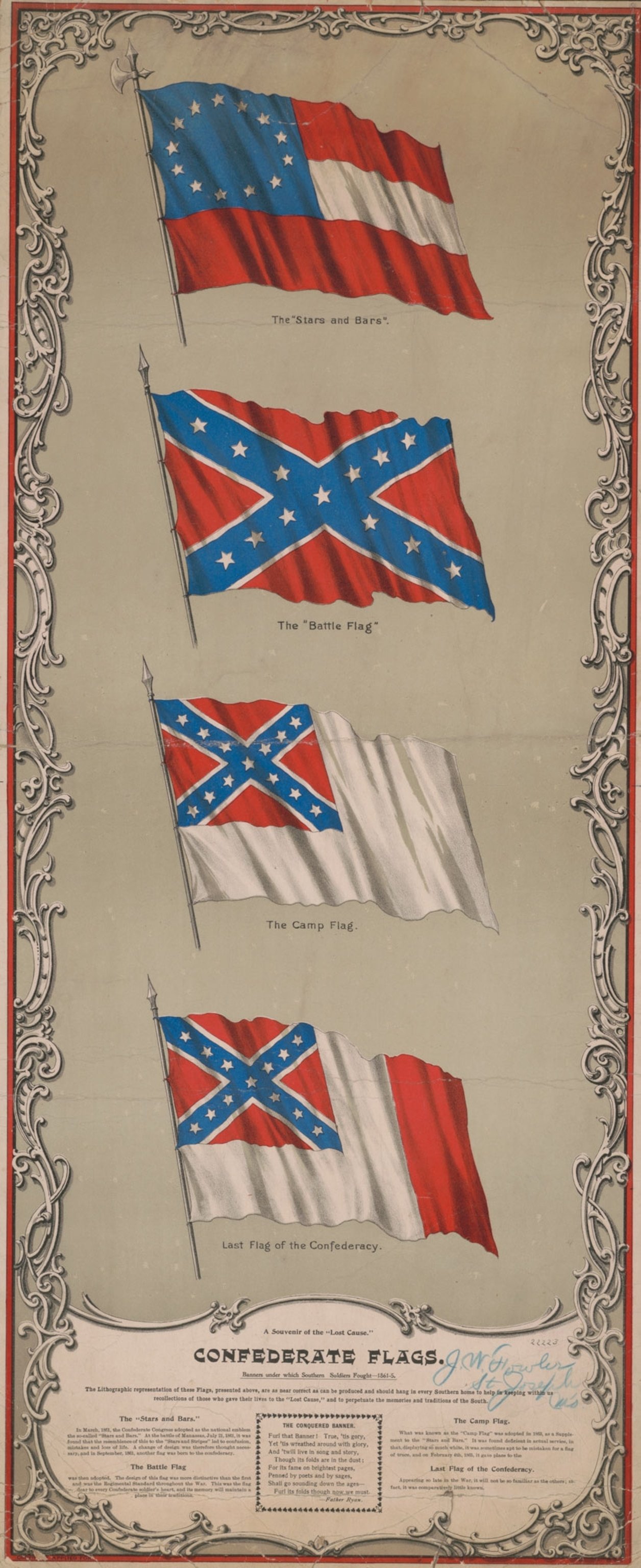
A lithograph from 1897 displays four prominent designs of the Confederate flag and states that the images “help in keeping within us recollections of those who gave their lives to the ‘Lost Cause,’ and to perpetuate the memories and traditions of the South.”
Photograph courtesy the Library of Congress
The Confederate flag’s rise from the Civil War
Though it came to symbolize the Confederate cause, the flag was never the official symbol of the Confederate States of America. Instead, it was one of multiple banners that emerged during the brief Civil War.
The CSA formed in the wake of the secession of 11 Southern states beginning in 1861. During the raid on Harper’s Ferry, West Virginia, that kicked off the rebellion, members of South Carolina’s militia identified themselves with a flag featuring a single white star on a dark blue background. Known as the “Bonnie Blue flag,” the lone star was quickly picked up as a symbol of Confederate bravery.
In 1862, the CSA adopted its first national flag, the “Stars and Bars.” With a white star representing each Confederate state and three stripes, the flag riffed on the Union flag.
On the battlefield, however, both looked similar enough to cause confusion among Confederate soldiers. The problem became tragically clear during the Civil War’s first battle, First Manassas.
As Confederate General Pierre Beauregard later recalled in his memoirs, he saw “a flag which I could not distinguish … I could not tell to which army the [waving] banner belonged.” “Friendly fire” and general disorientation caused frustration despite a victory for Confederate armies.
Why the Confederacy had multiple flags
Resolved never to inflict that type of confusion on his troops again, Beauregard asked his aide-de-camp, Confederate politician William Porcher Miles, to propose a design for a new battle flag. He came up with what is now known as the “Confederate Battle Flag,” featuring an X-shaped cross and white stars representing each state to secede from the Union.
The battle flag took hold in the public conscience. “The flag would have meant treason” for loyal Unionists, independent historian Kevin Levin says. “It would have been interpreted as [a symbol of] rebellion.”
Meanwhile, the Southern Cross took hold in the South. It did not, however, become the CSA’s official flag, though the Confederacy incorporated it in the left-hand corner of one of the three national flags it adopted over time.
A symbol of segregation
The Confederacy collapsed with its defeat in 1865, but its symbols retained their potency. “There’s continuity in how people understood its meaning,” says Levin.
After the war, the reunified U.S. abolished slavery and attempted to confer civil rights on Black men. But that period, known as Reconstruction, ended in 1877. With its end, Southerners set to work rebuilding the segregated racial and social order they had fought a war to maintain.
(Reconstruction offered a glimpse of equality for Black Americans. Why did it fail?)
Part of that new social order was Jim Crow, a restrictive system of racial segregation laws that barred Black Americans from voting, education, and other civil rights. The newly founded Ku Klux Klan violently enforced this social order. Both used the Confederate battle flag to do so.
At first, writes historian Gaines M. Foster for Zócalo Public Square, the battle flag was used regionally, tied to the memory of the war. By the early 20th century, it had become part of the myth of the “Lost Cause,” whose proponents held that the Civil War was fought not to uphold slavery, but to protect Southern states from Northern aggression.
The myth helped white Southerners come to terms with their defeat—and withstand the “economic, racial, and social uncertainty” of the postwar period, writes Caroline E. Janney, a historian at the University of Virginia. It also kept the Confederate battle flag waving long after the war’s end, as one of the most visible symbols of the Lost Cause.
(Where did ‘Jim Crow’ come from?)
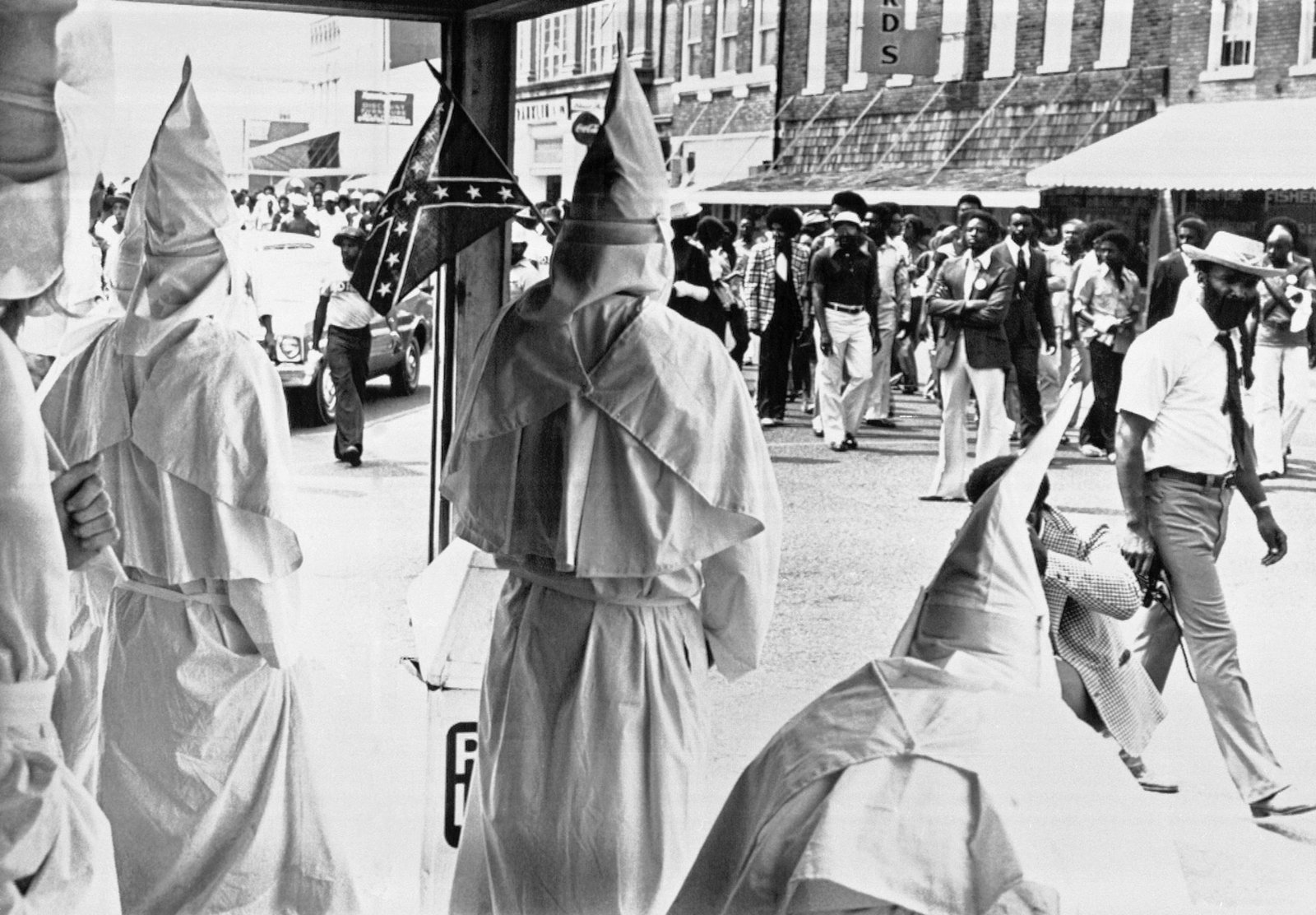
Robed Ku Klux Klan members watch Black demonstrators march through Okolona, Mississippi, in 1978. The protesters were demanding diverse hiring and were boycotting the area’s stores.
Photograph by JM, AP
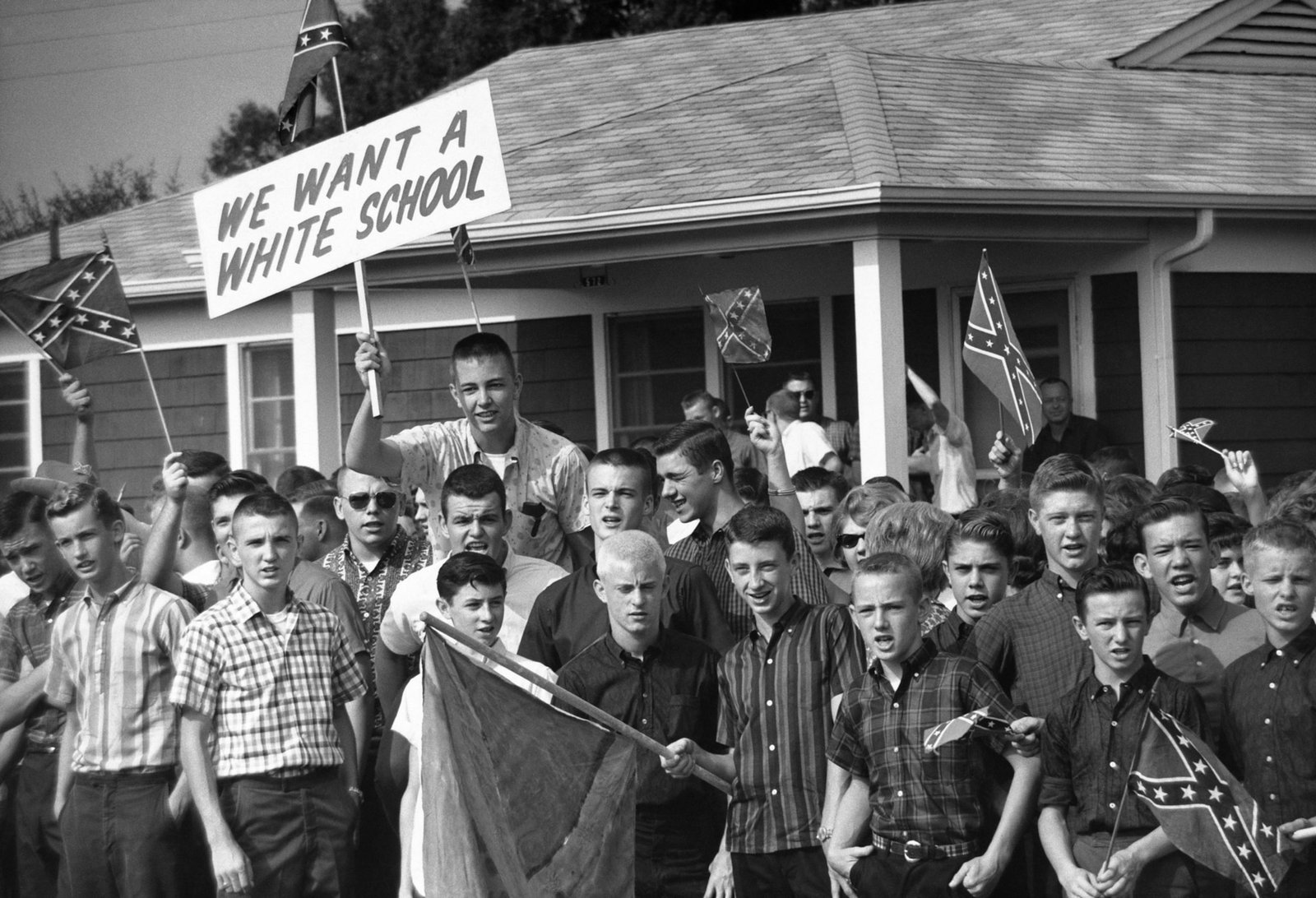
A crowd of white teenagers protest school integration in Montgomery, Alabama, in 1963.
Photograph by Flip Schulke, CORBIS/Corbis/Getty
The “flag fad” of 1948
The flag remained largely local, but that changed in 1948 with the “Dixiecrats,” or States’ Rights Democratic Party, a racist, pro-segregation splinter party formed by Southern Democrats.
They objected to the Democratic Party’s adoption of a pro-civil rights platform and were dismayed when hundreds of thousands of African Americans registered to vote in Democratic primaries after the Supreme Court declared all-white primaries unconstitutional.
The Dixiecrats’s adoption of the Confederate battle flag as a party symbol led to a surge in the banner’s popularity, and a “flag fad” spread from college campuses to Korean War battlefields and beyond.
The Southern Cross symbolized rebelliousness, historian John M. Coski writes in The Confederate Battle Flag: America’s Most Embattled Emblem. But now it gained “a more specific connotation of resistance to the civil rights movement and to racial integration.”
The identification stuck, and the flag’s use proliferated. “The flag emerges as a central symbol of massive resistance during the civil rights era,” says Levin.
Within decades, it was a staple for artists attempting to portray anti-establishment cool. It flew onstage with Lynyrd Skynyrd and adorned the Dukes’s car on the wildly popular The Dukes of Hazzard TV show.
Some claimed their use of the battle flag meant nothing more than Dixie pride and regional affiliations. But it retained its associations with hatred and racial terror, especially during the 1994 trial of white supremacist Byron De La Beckwith for the assassination of civil rights leader Medgar Evers 31 years earlier in 1963.
De La Beckwith wore a pin of the battle flag daily at the trial, making it impossible to forget his racial convictions. (He was convicted of murder.)
(How the assassination of Medgar Evers galvanized the civil rights movement.)
As the flag resurged in popularity, so did protests against its use. One noteworthy push against the flag was the NAACP’s 15-year economic boycott of South Carolina for its use of the banner.
Another was Coleman v. Miller, a 1997 lawsuit filed by a Black man who alleged Georgia’s use of the flag infringed on his 14th Amendment rights. Coleman ultimately lost his suit, but the suit spawned other attempts to remove the flag from the grounds of multiple state capitols.
Debates about the flag and its use never disappeared, says Levin—and it comes with a new set of potential meanings for different people. “There’s an eye of the beholder element in all this,” he says.
(How the U.S. Voting Rights Act was won—and why it’s under fire today)
There was little question about what the flag meant to Dylann Roof, a white supremacist who shot and killed nine churchgoers at the Emanual AME Church in Charleston, South Carolina, in 2015.
After images of the shooter carrying Confederate battle flags emerged, multiple states bowed to pressure to remove the symbol from public spaces.
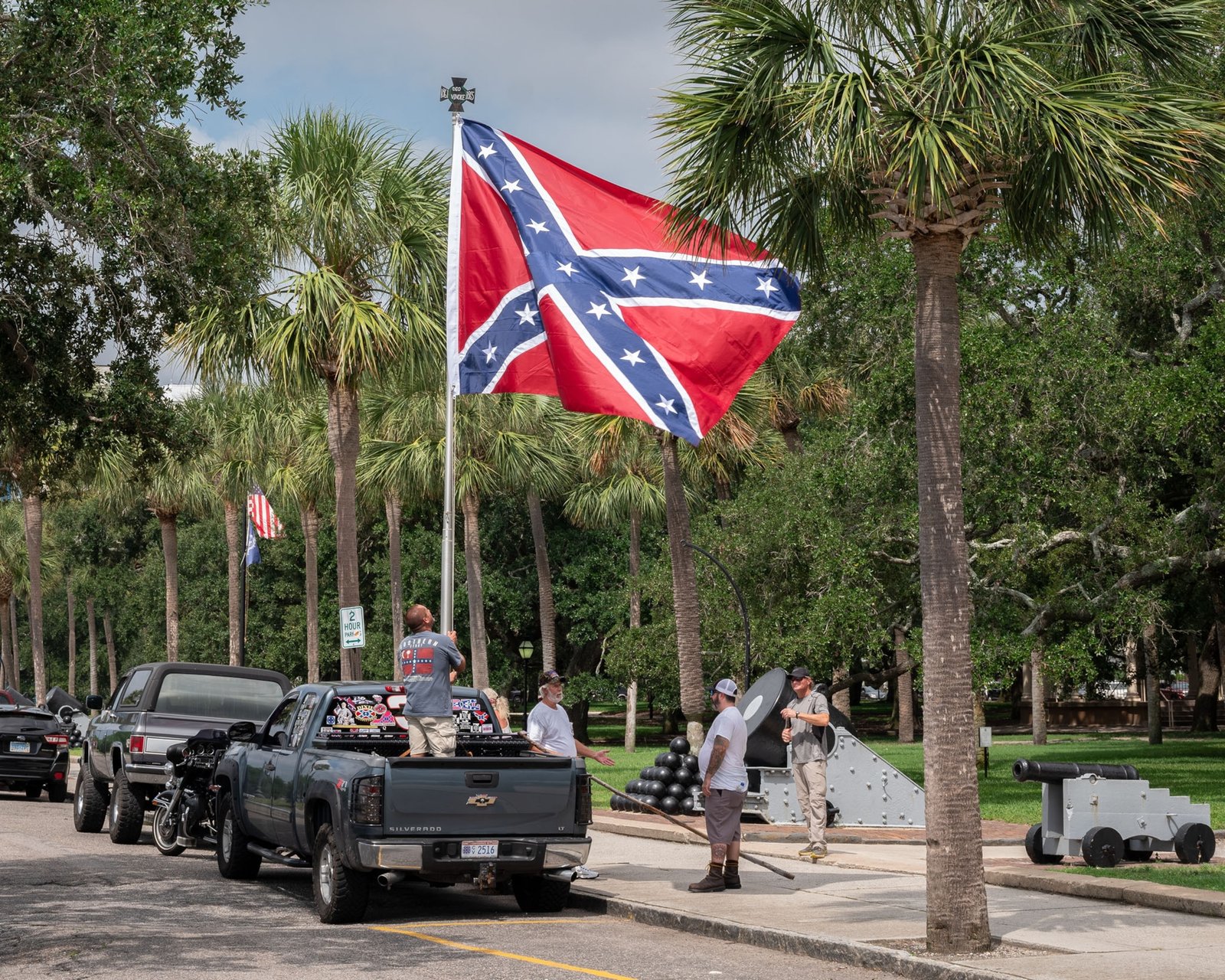
Men fly a massive Confederate flag during a Black Lives Matter protest in Charleston, South Carolina, in August, 2020.
Photograph by Kris Graves, National Geographic
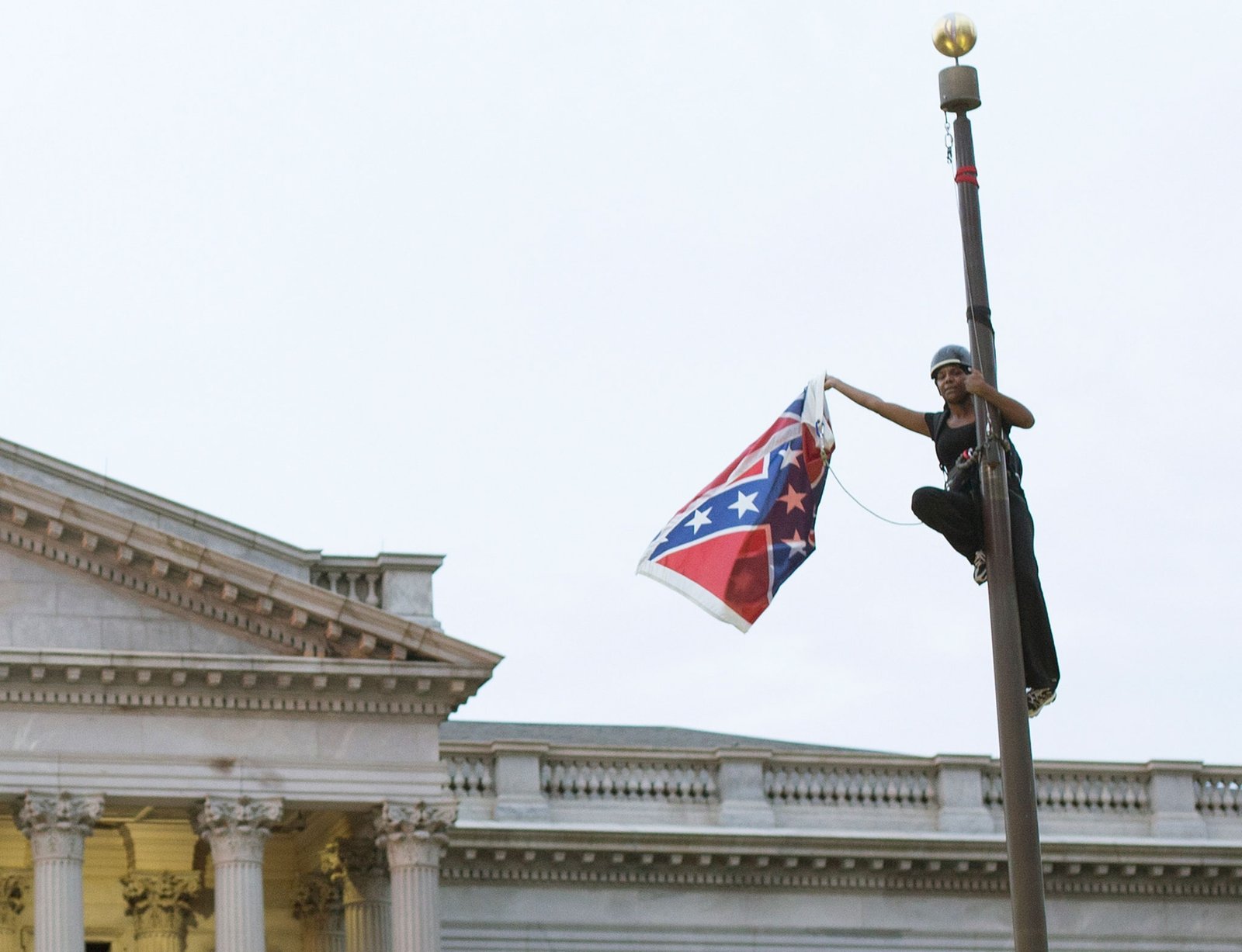
Activist and filmmaker Brittany “Bree” Newsome climbed a 30-foot pole outside of the South Carolina state capitol to remove the Confederate flag weeks after a shooting at a predominantly Black Charleston church in 2015. Newsome was arrested, but state officials voted to remove the flag from the building the following month.
Photograph by Adam Anderson, REUTERS
Why the Confederate flag continues to divide Americans
So what does the flag mean today? In a 2019 YouGov survey of nearly 35,000 U.S. adults, the polling firm found that a plurality of Americans (41 percent) think the flag symbolizes racism, but 34 percent think it symbolizes heritage.
Yet its use—and its controversy—endures. In the wake of the 2017 Charlottesville white supremacist rally, for example, demand for the banner surged across the country.
Levin doesn’t see the flag falling out of favor among extremist groups or white supremacists anytime soon. But he adds that public outcries and the social upheaval of recent years means the flag has been semi-retired, at least in official life.
“There’s still an element that will embrace the Confederate flag or other Confederate symbols,” he says, “but I think the question of whether they’re appropriate has already been answered.”
This story originally published on January 12, 2021. It was updated on August 8, 2025.


